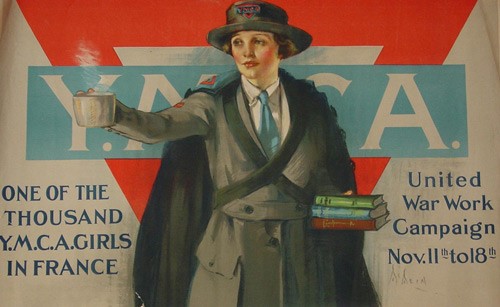Pamela Tronsor opened the art exhibit “Women and the Great War” Nov. 1 in the Hess Gallery in Zug Memorial Hall at Elizabethtown College. The exhibit features propaganda posters from World War I that feature women and their roles in the war, both on the home front and overseas.
“The exhibit is part of a larger program created by the Department of Fine and Performing Arts, which recognizes the 100th anniversary of the Armistice of Nov. 11, 1918,” said Professor of Art Milt Friedly.
Tronsor began collecting the posters after visiting a WWI exhibit called “Anthem for Doomed Youth” in London in 2002. While there, she wondered about the waste of the war, having never experienced the war in this way on a personal level.
“These posters are a rare combination of art and history,” Tronsor said in her opening remarks.
Then, during recovery from a biking accident, she read about the war voraciously while bedridden. From then on, Tronsor began collecting memorabilia from the war, including post cards, books and sheet music in addition to the posters.
“I’ve been collecting the posters for 10 years, and soon after I started, my interest turned to women. I now have 37 posters,” Tronsor said.
The posters were hung in America’s post offices, train stations, shop windows and on sides of buildings during America’s involvement in WWI. They were created to emphasize women’s involvement in the war effort. The ones featured in Tronsor’s collection are separated into the following four categories of theme or motif: mythic images of women, the conservation of food, women workers on the home front and women engaged overseas in the war effort.
“The posters depict women in important roles during WWI. They are informative and certainly help to recognize women doing their part,” Friedly said.
“It was an effort to bring the community into the war effort and perhaps romanticize war; rather than seeing the brutality of war, we see beautiful and somewhat romantic visions of war through propaganda,” Friedly said.
“The women depicted in the posters working overseas were not classified as soldiers until recently,” Tronsor said.
The U.S. government needed to sell the war to the American people, so they created the Division of Pictorial Publicity (DPP) since posters were a popular form of advertising. The DPP hired the help of Charles Dana Gibson, who was president of the Society of Illustrators, to direct it and oversee the volunteer artists, who mostly went on to be important commercial illustrators.
“The artists had a lot of freedom in creating these posters. The printing was mainly done in New York City, but there were also presses in cities like Chicago and San Francisco,” Tronsor said.
This was the first time that posters used advertising techniques on a mass scale for propaganda purposes and the first “media war” where advertising played such an important role. During the time that America was involved in WWI, the DPP and its artists created more than 2,500 poster design and printed more than 20 million posters using either silk-screening or lithography.
“Silkscreen is a process that is printed through silk or a synthetic material. Lithography is a chemical process done on plate or stone and is based on water and greasy ink repelling each other,” Friedly explained about the difference between the two.
“I use a conservation process on the posters because the original paper is very cheap and it deteriorates easily,” Tronsor said.
“Women and the Great War” will remain in the Hess Gallery through Dec. 1. It is free and open to the public for viewing.

